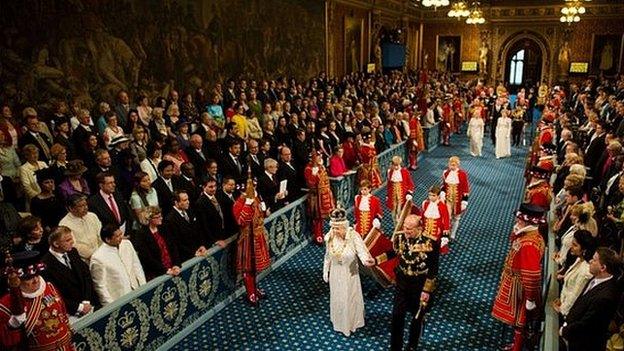The Queen shows us who isn't boss
- Published

The state opening of parliament reminds the Queen of her role in government.
Forget, if you can, the crowns and carriages. Dismiss from your mind the page boys and pageantry. Ignore the robes and royalty that fill your television screens.
For although we call the state opening of parliament colloquially "the Queen's speech", it is not really about her at all.
The formal opening of the political year is more about the government and parliament asserting their rights over the monarch than it is about the sovereign reminding us of her centrality to our constitution.
The Queen reads a speech that is written by someone else, namely the government. They make her repeat excruciating political slogans.
Her representative in the Palace of Westminster - we aficionados call him Black Rod - has the doors of the House of Commons slammed in his face to remind the monarch who is boss.
MPs deliberately choose to debate the way outlaws are treated before they get round to considering what the Queen has said.
As she processes through the Princes' Chamber in the House of Lords, there are two statues representing mercy and justice placed there on purpose to focus her mind as she prepares to deliver her speech. The route is dotted with pictures and statues of previous monarchs, as if Westminster were saying: "We have seen your like before."
And here is the really cheeky move: parliament forces Her Majesty to consider her own mortality as she gets dressed for the occasion. For in the Robing Room of the House of Lords, where the Queen puts on her robe and imperial state crown, the authorities have chosen to display a facsimile of the death warrant of her ancestor, Charles I.
If ever there were a symbol to express the end of the divine right of kings and the limits of a constitutional monarchy, that document is it.
But in a typically English way, we bend over backwards to be polite and respectful to Her Majesty while we circumscribe her power. The ceremonial is planned down to the last footfall to meet the Queen's high standards.
There is a full rehearsal presided over by the Earl Marshal, the Duke of Norfolk, who hates it if mistakes are made. The stand-in Queen is played brilliantly by his sister, Marsha Fitzalan-Howard, the actress best known for being Alan B'Stard's wife in the television comedy The New Statesman.
The heralds are told to keep the procession through the Royal Gallery slow so the 88-year old Queen does not get too puffed. Plans have already been put in place for the time when the crown becomes too heavy - it will be carried on a cushion instead as it was in the days of Victoria and Edward VII.
A gorgeous new carriage has been built - the Diamond Jubilee State Coach - to transport the Queen to Westminster with all mod cons: electric windows, heating and lighting, with wooden panels from the Victory, the Mary Rose and Scott's Antarctic base, and even a lead musket ball from the battlefield of Waterloo.
She is protected by real soldiers from the Household Cavalry and retired soldiers in the Yeoman of the Guard which to this day contains no sailors because they are still in disgrace for their mutiny at Spithead in 1797.
The sovereign is allowed to take a hostage from the government to ensure her safety, usually an expendable government whip who this year comes in the guiltless form of Desmond Swayne, who watches proceedings from the comfort of Buckingham Palace with a nice cup of tea.
Everyone gets dressed up in their finest tiaras and ermine for the occasion. Peers queue and wait for hours to get a good seat. And so on, and so on.
This might be a familiar date in the political calendar but it is still a big one.
The point is this: as you watch the state opening of parliament, remember it is one of the strongest ceremonial demonstrations of our liberty that we have. Democracy is not just the freedom to vote out a government we dislike; it is also the freedom not to be ruled by an autocratic monarch chosen by God.
It is what our ancestors fought over in the civil war. And it is a right that we are reminded of every year.
- Published4 June 2014
- Published29 May 2014
- Published15 May 2014